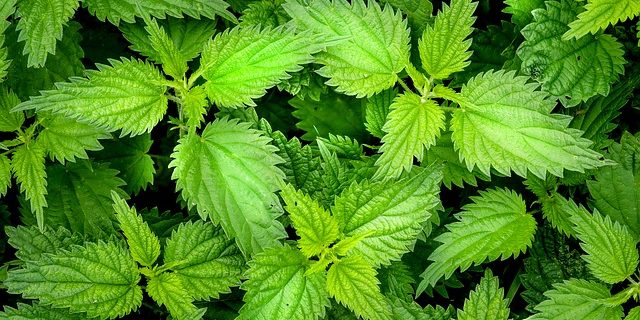Itchy, watery eyes, runny nose, sore throat, headache, coughing, sneezing: seasonal allergies can be a misery. For those who are particularly sensitive, allergy symptoms can include digestive upset and fatigue as well as the cold-like symptoms we easily recognize.
It’s been another wet summer in Maryland, which means that all the plants are growing like gangbusters. From mid-August to first frost is Ragweed season here, and while it’s a little slow to start this year, we can expect it to pick up soon. Right now grass pollen is still top dog in the world of allergies, but Ragweed will follow, and then mold in late September and into October.
Many people find relief from allergy shots administered by their doctors, and for some this is definitely the best option. Over the counter remedies may bring some relief, but they tend to have side effects that folks want to avoid. There are some great herbal options that have few side effects and help many people (myself included) stay on track through the season.
Below is a little information about the allergens headed our way, followed by my favorite herbs for preventing and treating allergies.
Ragweed
Ragweed is a common roadside plant, part of the Artemesia family, and its pollen is especially hard on allergy sufferers.
Don’t mistake Goldenrod, which grows in the same habitat, for Ragweed. Goldenrod is actually used medicinally to ease allergies (it’s in our house blend Sinus and Allergy Tea!), and is an important wildlife food source. By all means, cut down ragweed if you see it in your yard or neighborhood, but leave the goldenrod flowers for the bees and butterflies. Or take a few home for your tea.
Mold
As we move from late summer into fall, mold allergies begin to rear their ugly heads. For some this may come as a surprise—Isn’t allergy season over?!—but in September and October the fallen leaves, harvest décor, and dying vegetation in gardens and wild places are all hot spots for mold growth. There are some very practical things you can do to reduce mold growth around your home.
- Rake your leaves, and dispose of them—those damp piles of vegetable matter are a perfect spot for mold to grow
- Take down your tomato and squash vines when they stop producing—clearing those dying vines from your garden will discourage mold
- Put your jack-o-lantern up on a riser to increase airflow—this will reduce dampness, keeping the pumpkin fresher longer
- Avoid using straw bales or other dried foliage as decoration—they’re a magnet for damp and rot. Try re-usable decorations instead
- Keep your windows closed, even car windows, in case your neighbors aren’t as careful as you are not to let vegetation collect. On especially challenging mold days, you can run your central air conditioning unit without the cooling function. This will force the air in your home through the unit’s filters. Be sure to get your ducts cleaned and your filters changed regularly for this to have the greatest effect.
Herbs for Allergies
Stinging Nettles, Urtica dioca, is one of my desert island herbs. I take Nettles year-round for grounding, mineral-rich love, gentle joint support, and anti-inflammatory/anti-histimine properties. In the fall, as in the spring, I double up my dosing to protect my eyes, nose, throat, and lungs from the change of season. This herb is classified as astringent, slightly bitter, and cooling, and I find it incredibly soothing to my lungs and sinuses. It makes a lovely tea, fresh or dried, and adding a bit of Peppermint increases the sinus-clearing properties. Nettles in capsule or tincture is just as effective, and easy if you’re on the go. Don’t be afraid to take plenty of it, this herb is as safe as Kale or Spinach, and just as nutritious!
Turmeric, Curcuma longa, is a well known anti-inflammatory herb, and often used for joint pain among other things. I also like it as a digestive tonic, helping to soothe the small and large intestines, break down fats, and support the liver and gall bladder. It also is helpful, taken daily through the allergy season, to reduce inflammation in the respiratory system. Paired with Nettles, Turmeric reduces the red, itchy, swollen eyes and nose so common with allergies. It is slightly bitter and astringent, reduces mucus, and calms irritated tissues. Since my allergies seem to kick up at night, keeping me from sleeping well, I take a bigger dose in the evening. Turmeric’s anti-inflammatory action means it helps reduce nighttime aches and pains as well, which is always a bonus for deep sleep.
Reishi, Ganoderma lucidum, is a medicinal mushroom used for allergies, inflammation, and overall strenghth and vitality. A key ingredient in the “Seven Perfect Mushrooms” blend, Reishi has been used in Traditional Chinese Medicine for centuries. This common and easily grown mushroom is a tonic for the immune system, and is generally safe and effective as a strengthening herb throughout the year. I like it as a preventative tonic during cold and flu season as well as extra support to calm the immune system during allergy season. Allergies, as you probably know, are the immune system reacting to an invader. Some of those invaders, like oak pollen in the spring or ragweed pollen in the fall, are not actually that dangerous. Using an immune tonic like Reishi can help reduce the initial allergic reaction, which reduces symptoms. Since Reishi is also anti-inflammatory, it can also help soothes symptoms once they’ve started.
I hope you’ve found something here to make your fall allergy season a bit more pleasant. I’m always grateful for our herbal allies!








